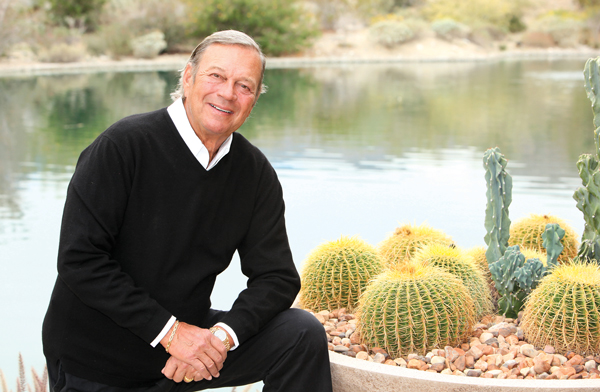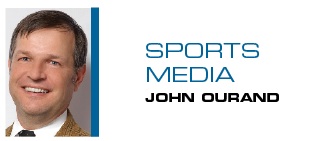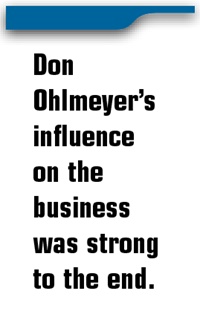A
ll of the obituaries for
Don Ohlmeyer last week carried the same themes. In
The New York Times,
Richard Sandomir referred to him as “a cocksure, creative personality.”
Variety’s
Cynthia Littleton noted that he “was a famously tough boss [who] brought a spirit of competitiveness to NBC in the early 1990s.” And
The Washington Post’s
Emily Langer described him as a “revered, if at times divisive, figure.”
Ohlmeyer last worked in a production truck in 2000 when ABC called on him to resuscitate “Monday Night Football.” Judging by much of the reaction to his Sept. 10 death, Ohlmeyer’s influence over the business remained strong to the end.
I wrote a profile on the broadcasting legend in 2012, and traveled to his house in Palm Springs, Calif., to conduct what became some of the most memorable interviews of my career.
 |
Longtime sports TV executive Don Ohlmeyer, who died Sept. 10, in Palm Springs, Calif., in 2012.
Photo by: RENE MACURA |
A chain-smoker who had embraced retirement, Ohlmeyer spent four hours telling stories of his 40-plus years in the business — stories that showed him to be “revered,” “cocksure” and “a tough boss.”
Here are two of his stories that did not make it into the final version of that feature. To me, they show the passion, vision and hard-driving nature of a man who will be remembered as one of the giants of sports television.
On creating the Skins Game …
I was watching a golf tournament back in the early 1980s and looked at the leaderboard. I felt like I was watching Butch Cassidy and the Sundance Kid. Who are these guys?
I said to a friend of mine, “Can you imagine if there was a golf tournament and the leaderboard was Palmer, Player, Nicklaus and Watson? People would be calling their neighbors to watch.
The problem was that Palmer and Player couldn’t really play 72 holes with these guys anymore. But on any given hole? That’s where I came up with the idea of a skins match over 18 holes. I remembered as a kid playing skins and thought it could work.
I talked to [Jack] Nicklaus and he was interested. He asked about appearance fees, which was something I had never thought about.
“I don’t know, Jack. Should we?” I asked.
“No, because if you pay us an appearance fee, it will just be viewed always as an exhibition. Whatever the prize money is, the prize money is. You’re talking about $360,000. That’s very attractive for a weekend of playing 18 holes,” he said.
[Arnold] Palmer was interested, too. I called Arnold and said, “Jack thinks there shouldn’t be an appearance fee.”
He said, “If Jack doesn’t want an appearance fee, I don’t want an appearance fee.”
Six weeks before the telecast, I still couldn’t get a network to license it. I finally decided to do it myself and did a time-buy on NBC for $1 million.
That’s when I went to IMG and brought in Barry Frank because I didn’t want to take the whole risk by myself. We made a deal to partner on it. Six weeks before the event, we were looking at losing up to $1.25 million. We put the pedal to the metal selling advertising and sold the last unit the Friday afternoon before the telecast. After busting our balls for a year, I think we ended up splitting $9,000.
It became one of the highest-rated golf telecasts of the year. After that, it was just name your price.
On dealing with the ‘Monday Night Football’ announcers …
Howard Cosell was difficult. Don Meredith was a handful in a totally different, more fun way. Frank [Gifford] was just the greatest person you’ve ever been around.
There was always a lot of tension between the announcers. We’re doing a game in Oakland. We’re staying at the Fairmont Hotel. We used to all go in one limousine — the three announcers, Chet Forte who was the director and me. They had become such stars that getting through a football crowd was hard.
About four weeks into the season, Howard decides that he wants to have his own limousine. He doesn’t want to ride with everybody because it was too crowded. One week, Chet would ride with Howard, and I’d ride with Frank and Don. The next week, I would ride with Howard and Chet would ride with Frank and Don.
This was my week to ride with Frank and Don. As we’re driving across the Bay Bridge, Frank turns to me and says, “Don, I just want you to know, we’re not going to talk to him tonight.”
“You’re what?” I asked.
“We’re not going to talk to him tonight,” he said again.
“Frank, you’re about to go on television and between 35 and 45 million people are going to be watching. You’re not going to talk to him at all,” I said.
“Yeah! We’re not going to talk to him,” Don chimed in.
“He keeps talking about the jockocracy. He keeps saying things in the press that are really kind of embarrassing to Don and me. We’re just not going to talk to him tonight,” Frank said.
“What if he asks you a question,” I asked.
“We’re not going to answer it,” Frank said.
“Yeah, we’re not going to answer it,” Don chimed in.
I spent the next 20 minutes explaining to them, yes, in fact, they were going to f----- talk to him. And in fact, they were going to be as charming as was humanly possible to him. By the end of the ride, everything had calmed down and the telecast went fine.
But the next week, I ordered three limousines: one with Frank and Don, one for Howard, and one for Chet and me. I decided that if these guys were going to put me in the f----- nuthouse, I was going to go in style.
John Ourand can be reached at jourand@sportsbusinessjournal.com. Follow him on Twitter @Ourand_SBJ.






